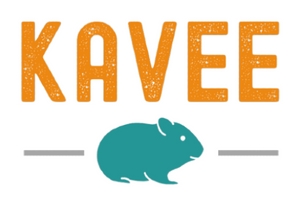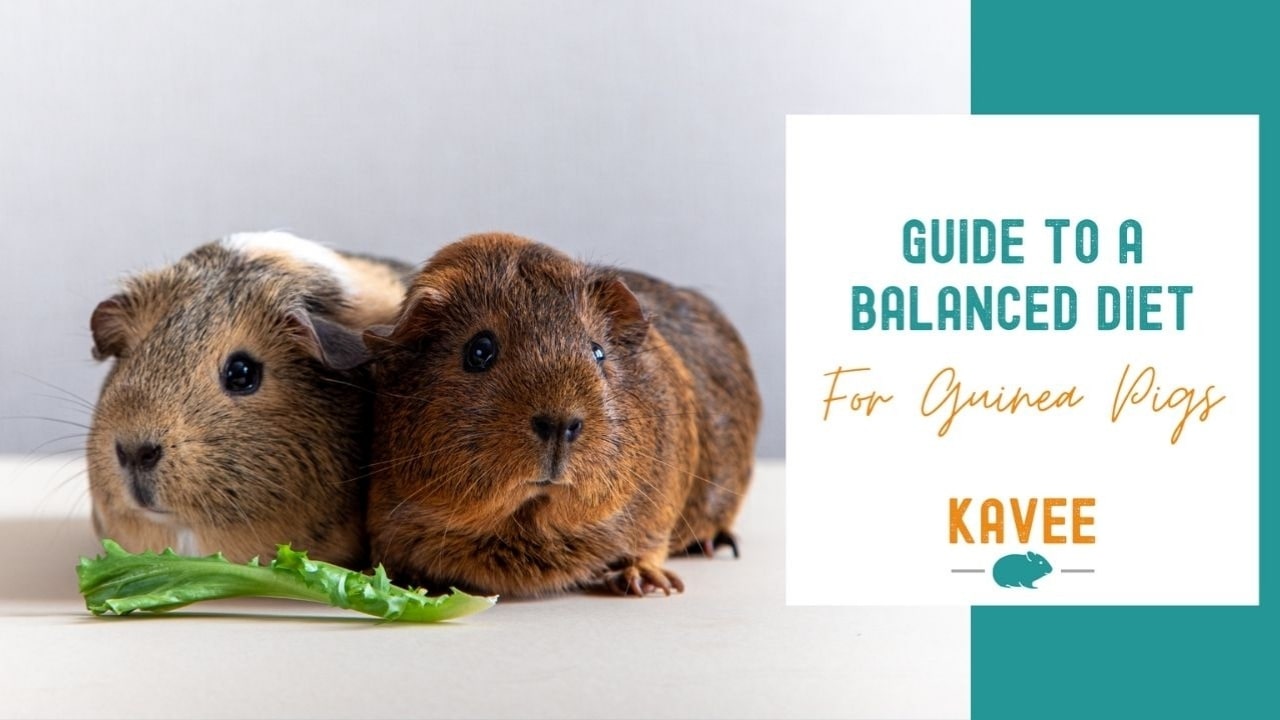We all know that the way to a guinea pig’s heart is through their stomach, but what food exactly contributes to their happiness and good health?
Any responsible piggy parent only wishes the best for their furry friends, and this starts with choosing the right diet. From everyday meals to treats, understanding which foods should be fed in moderation and which others to avoid can be a head-scratcher.
In this blog, we’ll look at everything that makes up a balanced diet for guinea pigs, which foods are safe or unsafe, and some other food-related considerations. Before you know it, you’ll have become the best chef for your piggies!
How often do guinea pigs eat?
As any experienced piggy pawrent will tell you, piggies love to eat! Guinea pigs will eat hay, grass, and leafy greens all day long. While you might think it’s just greed, their constant eating is good for their health as it keeps their teeth and gut in check.
However, overeating can be a concern. Monitor your piggy’s health by weighing them regularly to ensure they don’t become overweight. This also helps you spot if your piggy is losing weight, which is something that should immediately be checked by your vet.
What to Feed Guinea Pigs Daily
To start, it’s important to know that guinea pigs are herbivores. These little floofers thrive when munching on foods similar to what they would normally enjoy in the wild. Let’s walk you through all of the important components that make up a balanced guinea pig diet.
Hay and Grass
Fibre is the most important nutrient for guinea pigs, as it helps maintain good gut and dental health. To satisfy this need, make sure that your piggies have access to an unlimited supply of hay and grass. In fact, guinea pigs will eat a daily amount of hay as big as their body!
Baby guinea pigs under 6 months old will benefit from feeding on Alfafa hay, which is rich in calcium, while adult guinea pigs should switch to Timothy hay, which is equally nutritious but better to keep a healthy weight.
Do watch out if you decide to hand-pick the grass you feed to your floofers. The grass you collect has to be free from pesticides or chemicals, and hasn’t been contaminated by other animals.
Leafy Greens and Vegetables
Guinea pigs should have about a teacup of fresh leafy greens and vegetables everyday, to get all the much-needed nutrients. Keep their meals interesting by handing out different types of vegetables.
This level of moderation and variety is what ensures that your guinea pigs eat all the nutrients they need to thrive without overeating them, as that can potentially cause health issues (more on this later!).
Pellets
Pellets should never make up the majority of a guinea pig's daily meals, but can greatly complement a balanced diet. Grass-based pellets are the best type, but always make sure to check that the pellets you buy are suitable for piggies.
Ideally, you should give guinea pigs no more than one tablespoon of pellets a day. As these can quickly fill up their tummies and stop them from naturally grazing!

Foraging for Guinea Pigs
In the wild, guinea pigs would spend a good chunk of their time foraging for fresh grass and tasty plants. While we don’t expect every piggy parent to venture into the wilderness looking for safe plants, there are plenty of ways you can try to encourage foraging. Including simply hiding your piggy’s favourite treats within their cage to make mealtime more fun!
Whether you’re growing the plants yourself, hunting for them, or buying them, these are some of the safe plants you can get for your piggies and their benefits:
Dandelion leaves - Rich in Vitamins A, C & D, these leaves are great for encouraging feeding and boosting the immune system.
Parsley leaves - Rich in Vitamin C, folic acid, and ferric.
Blackberry leaves - High in Vitamin C, with anti-inflammatory and anti-bacterial properties.
Rose petals - Rich in Vitamin C.
Marigold petals - Support the immune system and improve the digestive system.
Blue cornflower - Improves digestion and encourages feeding.
There are more safe plants you can find in the wild, but one thing you should always remember is to avoid picking them from areas busy with animals and people, or that have been treated with pesticides.

Best Guinea Pig Treats
Whether it’s to celebrate their Gotcha Day or reward them for being the best furry companions, a tasty treat is sure to make your piggy’s day. But what are some of the safe and healthy treats that you can hand out when needed?
Safe Veggies and Fruits
Vegetables and fruits can make a great addition to a guinea pig’s diet as they’re rich in many health-boosting nutrients. However, the type you choose does play a big role in your meal portions and frequency. For example, guinea pigs can eat broccoli, but while rich in nutrients, they can cause bloating if fed too often. In the same way, guinea pigs can eat pineapple as it’s rich in Vitamin C, but only a few times a week due to its high sugar content.
If you’re unsure whether a veggie or fruit that you have at hand can be fed to your piggy - and what health benefits they have - we recommend you check this nutrition chart by Guinea Linx.
Safe Herbs
A variety of herbs also make great healthy guinea pig treats. They’re rich in many important nutrients, but as always, moderation is key. Herbs should only be fed a few times a week and in small amounts.
Here are some of the herbs you can feed to guinea pigs:
- Basil
- Dill
- Mint
- Thyme
- Coriander

Foods Guinea Pigs Should Not Eat
There are certain foods that every piggy should avoid as they are either toxic, a choking hazard, or more likely to cause an upset tummy. For example, guinea pigs can not eat lettuce if it’s of the iceberg variety, as its high water content may cause diarrhoea. Here are some more examples:
- Iceberg Lettuce
- Garlic
- Onions
- Mushrooms
- Potatoes
- Nuts & Seeds
If you’re ever unsure about a specific food, don’t hesitate to ask your vet or check its safety on trusted sources.
Common Health Concerns for Guinea Pigs
The right diet and correct portion sizes are key to ensuring that your piggy assimilates all the important nutrients. If they eat too much or not enough of a certain food, they could become more prone to develop the following health issues.
Vitamin C Deficiency
Guinea pigs can’t produce any Vitamin C, and so rely on you to supplement their diet with foods rich in this nutrient. A lack of Vitamin C can lead to ‘scurvy’, and cause symptoms such as swollen joints, difficulty healing wounds, and dental issues.
The simple solution is to regularly feed piggies with foods that are rich in Vitamin C like bell peppers, spinach, and parsley.
Gut Stasis
One of the most worrying health conditions in guinea pigs is ‘gut stasis’, where a piggy’s gut slows down so much to the point that it stops working completely. There are a few things that can cause this, including dental issues, stress, or a lack of fibre in their diet.
The main way to prevent gut stasis is to ensure your piggies get an unlimited supply of hay and grass to support their high-fibre diet.
Overgrown Teeth
A guinea pig’s teeth grow continuously and there is no better way to prevent dental issues than by feeding the right guinea pig diet. In fact, it’s by chewing on grass and hay that they can naturally trim down their teeth.
Without this essential food, their teeth will overgrow and cause discomfort to your piggy, potentially stopping them from eating. Another reason why a balanced diet is so important!

Bladder Stones
Guinea pigs are prone to developing bladder stones, a condition where small stones of buildup form in the bladder. While there is no clear cause for this, a diet with a high intake of calcium is more likely to cause bladder stones in guinea pigs.
So take care to avoid overfeeding your piggies with foods that are rich in calcium. This is an important nutrient for the diet of your guinea pig, but should only be fed in moderation.
Upset Stomach and Diarrhoea
Any new foods should be gradually introduced to your piggies over 2 to 4 weeks to avoid upsetting their stomach. Ideally, you should stick to small portion sizes and mix them with their old food to make it easier for them to get used to the new flavors.
If it wasn’t clear already, your piggies are really sensitive to what they eat! Any imbalances in their diet (such as too many carbs or treats) can cause diarrhoea. This can also be caused by feeding your piggies a ‘muesli’ style mix or foods that have expired. An upset tummy and diarrhoea can also point to other issues, and should always call for a vet visit.

Conclusion
If it was up to your piggies, they would munch on everything that gets close to their faces without a hint of hesitation. That’s why it’s so important that as a responsible piggy parent, you take control of your guinea pig’s diet.
Picking the right foods and correct portion sizes are what significantly contribute to the happiness and health of your piggies. Whether it’s treats or food to forage, your piggy’s tummy will thank you for being so careful in your choices.
We hope that this guide has helped you better understand what should make up your guinea pig’s diet. A great way to ensure many more excited wheeks and cuddles!









